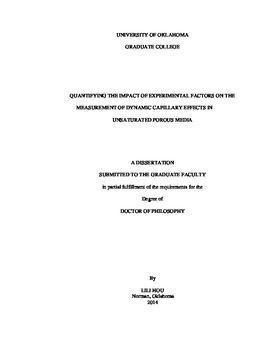| dc.contributor.advisor | Kibbey, Tohren | |
| dc.contributor.author | Hou, Lili | |
| dc.date.accessioned | 2014-11-24T15:53:28Z | |
| dc.date.available | 2014-11-24T15:53:28Z | |
| dc.date.issued | 2014-12-12 | |
| dc.identifier.uri | https://hdl.handle.net/11244/13630 | |
| dc.description.abstract | Multiphase flow is an important phenomenon in many natural and engineering systems; for example, oil recovery and water movement in the unsaturated zone are two common multiphase flow systems. The capillary pressure-saturation (Pc-Sw) relationship, a constitutive relationship between pressure between phases (the capillary pressure, Pc) and the water saturation (Sw), has been studied over nearly the past hundred years. Studies of Pc-Sw relationships are complicated by the often-reported observation of dynamic capillary effects. Dynamic capillary effects refer to a range of observed capillary phenomena which appear to occur under conditions of dynamic saturation change. One of the most widely investigated dynamic effects is the observed rate-dependence of capillary pressures. The focus of the work described here was on studying dynamic capillary effects in the Pc-Sw relationship. Specifically, the work aimed to understand how measurement factors impact the magnitude of observed dynamic capillary effects.
A number of studies have experimentally investigated the magnitude of dynamic capillary effects. Many have calculated a dynamic capillary coefficient, τ, as a measure of the magnitude of dynamic capillary effects. The results of reported τ values have differed widely from each other, even for systems with seemingly very similar properties. Furthermore, studies have reported different dependencies between system properties and dynamic effects. However, few studies have examined how features of the measurement system have impacted the accuracy of data collected. In this study, three important factors in the measurement were examined: response rates of pressure sensors, gas pressure drops through porous media, and unavoidable spatial averaging in saturation measurement. Unsaturated drainage experiments in a small-size cell (1.27 cm ID × 2.54 cm H) and a larger column (2.54 cm ID × 15.24 cm H) were conducted to investigate the impact of sensor response and gas pressure gradients on measurement of dynamic effects, and simulations were used to evaluate the effects of gas pressure drops and unavoidable spatial averaging.
Results show that the response rate of pressure sensors has a pronounced impact on the measurement of τ, particularly in systems where drainage is rapid. Even if sensors for both wetting and non-wetting phases respond rapidly, if their response rates do not match each other, the mismatched sensor responses can mimic dynamic capillary effects. Results also show that dynamic capillary pressures determined can be significantly greater than their actual values due to internal gas pressure drops or gradients, if inlet gas pressures are taken as gas phase pressures. The extent of gas pressure drops depends on both porous medium properties and boundary properties. Finally, results show that differences between local and spatially-averaged saturations as well as rates of saturation change can potentially amplify τ values calculated from measurements. The extent of the amplification is impacted by fluid properties and flow conditions of the multiphase flow system. | en_US |
| dc.language | en_US | en_US |
| dc.subject | Hydrology. | en_US |
| dc.subject | Engineering, Environmental. | en_US |
| dc.subject | Agriculture, Soil Science. | en_US |
| dc.title | Quantifying the Impact of Experimental Factors on the Measurement of Dynamic Capillary Effects in Unsaturated Porous Media | en_US |
| dc.contributor.committeeMember | Civan, Faruk | |
| dc.contributor.committeeMember | Kolar, Randal | |
| dc.contributor.committeeMember | Miller, Gerald | |
| dc.contributor.committeeMember | Muraleetharan, Kanthasamy | |
| dc.date.manuscript | 2014 | |
| dc.thesis.degree | Ph.D. | en_US |
| ou.group | College of Engineering::School of Civil Engineering and Environmental Science | en_US |
| shareok.nativefileaccess | restricted | en_US |
